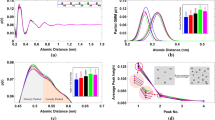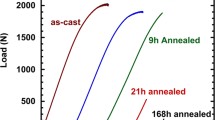Abstract
According to previous studies on the fracture surface morphologies of bulk metallic glasses, the stable crack growth region width and vein pattern size increase with the plasticity at room temperature. In the present work, the fracture surface morphologies of Ti- and Zr-based bulk metallic glasses bent over a wide temperature range (0.1–0.8 glass transition temperature) are systematically analyzed. According to our finding, the stable crack growth region width increases while the vein pattern size decreases as the ductility improves by varying temperature. This observation is in contrast to the common thought that the ductility is proportional to the stable crack growth region width and vein pattern size simultaneously. Moreover, the vein pattern size and shear offset width are found to be almost equal at a specific temperature. Furthermore, smaller vein pattern size and shear offset width reduce shear band instability and, consequently, enhance the ductility.








Similar content being viewed by others
References
Schuh CA, Hufnagel TC, Ramamurty U (2007) Mechanical behavior of amorphous alloys. Acta Mater 55:4067–4109. https://doi.org/10.1016/j.actamat.2007.01.052
Ashby MF, Greer AL (2006) Metallic glasses as structural materials. Scr Mater 54:321–326. https://doi.org/10.1016/j.scriptamat.2005.09.051
Argon AS, Salama M (1976) The mechanism of fracture in glassy materials capable of some inelastic deformation. Mater Sci Eng 23:219–230. https://doi.org/10.1016/0025-5416(76)90198-1
He Q, Shang JK, Ma E, Xu J (2012) Crack-resistance curve of a Zr–Ti–Cu–Al bulk metallic glass with extraordinary fracture toughness. Acta Mater 60:4940–4949. https://doi.org/10.1016/j.actamat.2012.05.028
Schroers J, Johnson WL (2004) Ductile bulk metallic glass. Phys Rev Lett 93:20–23. https://doi.org/10.1103/PhysRevLett.93.255506
Xi XK, Zhao DQ, Pan MX, Wang WH, Wu Y, Lewandowski JJ (2005) Fracture of brittle metallic glasses: brittleness or plasticity. Phys Rev Lett 94:25–28. https://doi.org/10.1103/PhysRevLett.94.125510
Ravichandran G, Molinari A (2005) Analysis of shear banding in metallic glasses under bending. Acta Mater 53:4087–4095. https://doi.org/10.1016/j.actamat.2005.05.011
Raghavan R, Murali P, Ramamurty U (2009) On factors influencing the ductile-to-brittle transition in a bulk metallic glass. Acta Mater 57:3332–3340. https://doi.org/10.1016/j.actamat.2009.03.047
Greer AL, Cheng YQ, Ma E (2013) Shear bands in metallic glasses. Mater Sci Eng R Rep 74:71–132. https://doi.org/10.1016/j.mser.2013.04.001
Narasimhan R, Tandaiya P, Singh I, Narayan RL, Ramamurty U (2015) Fracture in metallic glasses: mechanics and mechanisms. Int J Fract 191:53–75. https://doi.org/10.1007/s10704-015-9995-3
Zhang QS, Zhang W, Inoue A (2007) Transition from plasticity to brittleness in Cu–Zr-based bulk metallic glasses. Mater Trans 48:1272–1275. https://doi.org/10.2320/matertrans.MF200620
Liu YH, Wang G, Wang RJ, Zhao DQ, Pan MX, Wang WH (2007) Super plastic bulk metallic glasses at room temperature. Science 315:1385–1388. https://doi.org/10.1126/science.1136726
Lewandowski JJ, Wang WH, Greer AL (2005) Intrinsic plasticity or brittleness of metallic glasses. Philos Mag Lett 85:77–87. https://doi.org/10.1080/09500830500080474
Demetriou MD, Launey ME, Garrett G, Schramm JP, Hofmann DC, Johnson WL, Ritchie RO (2011) A damage-tolerant glass. Nat Mater 10:123–128. https://doi.org/10.1038/nmat2930
Conner RD, Johnson WL, Paton NE, Nix WD (2003) Shear bands and cracking of metallic glass plates in bending. J Appl Phys 94:904–911. https://doi.org/10.1063/1.1582555
Conner RD, Li Y, Nix WD, Johnson WL (2004) Shear band spacing under bending of Zr-based metallic glass plates. Acta Mater 52:2429–2434. https://doi.org/10.1016/j.actamat.2004.01.034
Wang G, Wang YT, Liu YH, Pan MX, Zhao DQ, Wang WH (2006) Evolution of nanoscale morphology on fracture surface of brittle metallic glass. Appl Phys Lett. https://doi.org/10.1063/1.2354011
Narayan RL, Tandaiya P, Narasimhan R, Ramamurty U (2014) Wallner lines, crack velocity and mechanisms of crack nucleation and growth in a brittle bulk metallic glass. Acta Mater 80:407–420. https://doi.org/10.1016/j.actamat.2014.07.024
Gu XJ, Poon SJ, Shiflet GJ, Lewandowski JJ (2010) Compressive plasticity and toughness of a Ti-based bulk metallic glass. Acta Mater 58:1708–1720. https://doi.org/10.1016/j.actamat.2009.11.013
Qiao JW, Ma SG, Wang GY, Jiang F, Liaw PK, Zhang Y (2011) Tension-tension-fatigue behaviors of a Zr-based bulk-metallic-glass-matrix composite. Metall Mater Trans A Phys Metall Mater Sci 42:2530–2534. https://doi.org/10.1007/s11661-011-0788-7
Philo SL, Heinrich J, Gallino I, Busch R, Kruzic JJ (2011) Fatigue crack growth behavior of a Zr58.5Cu15.6Ni12.8Al10.3Nb2.8 bulk metallic glass-forming alloy. Scr Mater 64:359–362. https://doi.org/10.1016/j.scriptamat.2010.10.042
Wang G, Zhao DQ, Bai HY, Pan MX, Xia AL, Han BS, Xi XK, Wu Y, Wang WH (2007) Nanoscale periodic morphologies on the fracture surface of brittle metallic glasses. Phys Rev Lett 98:1–4. https://doi.org/10.1103/PhysRevLett.98.235501
Flores KM, Dauskardt RH (2006) Mode II fracture behavior of a Zr-based bulk metallic glass. J Mech Phys Solids 54:2418–2435. https://doi.org/10.1016/j.jmps.2006.05.003
Wang C, Cao QP, Wang XD, Zhang DX, Ramamurty U, Narayan RL, Jiang JZ (2017) Intermediate temperature brittleness in metallic glasses. Adv Mater. https://doi.org/10.1002/adma.201605537
Suh J-Y, Conner RD, Kim CP, Demetriou MD, Johnson WL (2010) Correlation between fracture surface morphology and toughness in Zr-based bulk metallic glasses. J Mater Res 25:982–990. https://doi.org/10.1557/JMR.2010.0112
Tandaiya P, Narasimhan R, Ramamurty U (2013) On the mechanism and the length scales involved in the ductile fracture of a bulk metallic glass. Acta Mater 61:1558–1570. https://doi.org/10.1016/j.actamat.2012.11.033
Zhang ZF, Eckert J, Schultz L (2003) Difference in compressive and tensile fracture mechanisms of Zr59Cu20Al10Ni8Ti3 bulk metallic glass. Acta Mater 51:1167–1179. https://doi.org/10.1016/S1359-6454(02)00521-9
Jiang MQ, Ling Z, Meng JX, Dai LH (2008) Energy dissipation in fracture of bulk metallic glasses via inherent competition between local softening and quasi-cleavage. Philos Mag 88:407–426. https://doi.org/10.1080/14786430701864753
Murali P, Guo TF, Zhang YW, Narasimhan R, Li Y, Gao HJ (2011) Atomic scale fluctuations govern brittle fracture and cavitation behavior in metallic glasses. Phys Rev Lett 107:1–5. https://doi.org/10.1103/PhysRevLett.107.215501
Singh I, Guo TF, Narasimhan R, Zhang YW (2014) Cavitation in brittle metallic glasses—effects of stress state and distributed weak zones. Int J Solids Struct 51:4373–4385. https://doi.org/10.1016/j.ijsolstr.2014.09.005
Ngai K, León C (2002) Cage decay, near constant loss, and crossover to cooperative ion motion in ionic conductors: insight from experimental data. Phys Rev B 66:64308. https://doi.org/10.1103/PhysRevB.66.064308
Wang Z, Ngai KL, Wang WH, Capaccioli S (2016) Coupling of caged molecule dynamics to Johari-Goldstein β-relaxation in metallic glasses. J Appl Phys 119:024902. https://doi.org/10.1063/1.4939676
Asadi Khanouki MT, Tavakoli R, Aashuri H (2017) Effect of the strain rate on the intermediate temperature brittleness in Zr-based bulk metallic glasses. J Non Cryst Solids 475:172–178. https://doi.org/10.1016/j.jnoncrysol.2017.09.001
Yu HB, Shen X, Wang Z, Gu L, Wang WH, Bai HY (2012) Tensile plasticity in metallic glasses with pronounced β relaxations. Phys Rev Lett 108:1–5. https://doi.org/10.1103/PhysRevLett.108.015504
Lewandowski JJ, Greer AL (2006) Temperature rise at shear bands in metallic glasses. Nat Mater 5:15–18. https://doi.org/10.1038/nmat1536
Deibler LA, Lewandowski JJ (2012) Outer medium effects and fracture nucleation sites in model experiments to mimic fracture surface features of metallic glasses. Mater Sci Eng, A 538:259–264. https://doi.org/10.1016/j.msea.2012.01.040
Deibler LA, Lewandowski JJ (2010) Model experiments to mimic fracture surface features in metallic glasses. Mater Sci Eng, A 527:2207–2213. https://doi.org/10.1016/j.msea.2009.10.072
Takayama S, Maddin R (1975) Fracture of amorphous Ni–Pd–P alloys. Philos Mag 32:457–470. https://doi.org/10.1080/14786437508219968
Wang Q, Zhang ST, Yang Y, Dong YD, Liu CT, Lu J (2015) Unusual fast secondary relaxation in metallic glass. Nat Commun 6:7876. https://doi.org/10.1038/ncomms8876
Pan D, Inoue A, Sakurai T, Chen MW (2008) Experimental characterization of shear transformation zones for plastic flow of bulk metallic glasses. Proc Natl Acad Sci USA 105:14769–14772. https://doi.org/10.1073/pnas.0806051105
Jiang F, Jiang MQ, Wang HF, Zhao YL, He L, Sun J (2011) Shear transformation zone volume determining ductile–brittle transition of bulk metallic glasses. Acta Mater 59:2057–2068. https://doi.org/10.1016/j.actamat.2010.12.006
Acknowledgements
M.T.A. would like to thank the support of the International Center for New-Structured Materials (ICNSM) and Laboratory of New-Structured Materials, School of Materials Science and Engineering, Zhejiang University, for its hospitality during his visiting period in this center. Furthermore, constructive discussions and suggestions by Prof. Jiang, Dr. Cao and Dr. Wang during this period are greatly acknowledged. He also thanks the Iranian Ministry of Sciences and Materials Science and Engineering Department of Sharif University of Technology for financial support of his visit.
Author information
Authors and Affiliations
Corresponding authors
Ethics declarations
Conflict of interest
The authors declare that there are no conflicts of interest associated with the submitted work.
Rights and permissions
About this article
Cite this article
Asadi Khanouki, M.T., Tavakoli, R. & Aashuri, H. Effect of temperature on the fracture surface morphology of Ti- and Zr-based bulk metallic glasses: exploring correlation between morphology and plasticity. J Mater Sci 53, 10372–10382 (2018). https://doi.org/10.1007/s10853-018-2284-6
Received:
Accepted:
Published:
Issue Date:
DOI: https://doi.org/10.1007/s10853-018-2284-6




